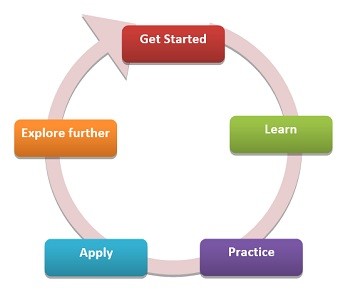Introduction | Get Started | Learn | Practice | Apply | Explore Further | Checkpoint
You can navigate through the sections and topics under each step by clicking on the boxes below. To review a section again, simply click on one of the boxes. You can come back to any section at anytime!

“How much will this cost to produce?” – That is usually one of the first questions asked about a new product or invention. Answering it can be a never ending exercise as production estimates are not one time events. Even after production starts, there are always new ways to refine methods and reduce costs.
TIP: You can get some idea of the cost to manufacture a product by comparing it to other products that are similar to yours.
You will learn:
- How to roughly estimate manufacturing cost
- How to calculate start-up costs
- What information to provide to get a detailed estimate
- What a typical estimate includes
- Why a Product Development Strategy is critical
- How patents and manufacturing are related
- How to get your idea ready for a manufacturing estimate
Very Rough Estimates
An initial estimation can come by comparing the cost of a similar item your company already creates, or a similar product already on the market. This does not necessarily mean similar in function; it means similar in production process. Manufacturing cost will be similar for items with similar production methods if they are produced in similar quantities, and are of similar size, quality and complexity. The manufacturing cost can be approximated through the retail price if the mark up of the distribution chain can be established. For typical consumer products, an overall mark up of around three to four times the manufacturing cost is a reasonable starting point.
A Simple Example
Suppose you have an idea for a new product to sell in grocery stores. You identify two other products that combined contain a similar number, size and type of parts. Their combined price is about $12 and the demand for these items is about what you forecast for your new product. Therefore the cost to manufacture your product might be about $3 to $4 ($12÷4=$3 & $12÷3=$4). Costs might be higher if your volume is lower, but it is a place to start.
It is important to learn about the typical mark up in the distribution chain for products like yours. Each participant in the chain will only want to handle your product if they make their usual profit.
Getting Started – What does it cost?
The cost determined by the above method is useful, but is only preliminary. For one thing, it ignores the investment needed prior to production. Manufacturing comes with start-up costs. Elements such as development, design, and tooling need to be considered. It is useful for making an initial commitment to suppliers for your first order, which will be one of the largest components of start-up costs. Manufacturing cost times the typical minimum order for each item needed will give a good first estimate of the necessary financial investment.
Can you afford this?
If you are ordering from overseas and looking for volume discounts, a minimum order quantity could be as much as 30,000 to 50,000. That means the commitment to suppliers for an initial order could be $90,000 to $200,000. ($3×30,000 & $4×50,000). Of course there are other costs to consider, but this estimate would give you the minimum starting point.
Then there are all the other costs required to launch a business – office space, advertising, administration, etc. Few investors are willing to risk capital without credible proof that the product has a competitive chance for success. A short-run production is often done as an initial step with the goal of minimizing that risk prior to going into full production.
New ventures need to work extra hard at making their pitch because they have no track record with new product introductions. Investors will be very interested seeing proof that team members have experience in the field through previous employment or endeavours or that research has been thoroughly conducted. As a new business, if your leadership team is inexperienced, far more work will need to go into creating a detailed estimation in order to procure funding.